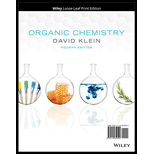
ORGANIC CHEMISTRY-PRINT COMPANION (LL)
4th Edition
ISBN: 9781119659594
Author: Klein
Publisher: WILEY
expand_more
expand_more
format_list_bulleted
Question
Chapter 16.5, Problem 10PTS
Interpretation Introduction
Interpretation: The treatment of 1,4-dimethycyclohepta-1,3-diene with one equivalent of HBr at the elevated temperature given 1,2-adduct rather than 1,4-adduct should be explained.
Concept Introduction : The compound which has more substituted pi bond (
Expert Solution & Answer
Want to see the full answer?
Check out a sample textbook solution
Students have asked these similar questions
11. Trans-1-bromo-2-methylcyclohexane will yield a non-Zaitsev elimination product (3-
methylcyclohexene) upon reaction with KOH. Show this reaction by drawing the chair
conformations of the reactant and product. Include the curved arrows and explain why the
product is not a non-Zaitsev product. (
Dehydrohalogenation of 1-chloro-1-methylcyclopropane affords two alkenes (A and B) as products. Explain why A is the major product despite the fact that it contains the less substituted double bond.
When buta-1,3-diene (CH2 = CH – CH = CH2) is treated with HBr, two constitutional isomers are formed, CH3CHBrCH = CH2 and BrCH2CH = CHCH3. Draw a stepwise mechanism that accounts for the formation of both products.
Chapter 16 Solutions
ORGANIC CHEMISTRY-PRINT COMPANION (LL)
Ch. 16.1 - Prob. 1CCCh. 16.2 - Prob. 2CCCh. 16.2 - Prob. 3CCCh. 16.2 - Prob. 4CCCh. 16.3 - Draw an energy diagram showing the relative energy...Ch. 16.4 - Prob. 1LTSCh. 16.4 - Prob. 6PTSCh. 16.4 - Prob. 7PTSCh. 16.5 - Prob. 2LTSCh. 16.5 - Predict the products for each of the following...
Ch. 16.5 - Prob. 10PTSCh. 16.5 - Prob. 12CCCh. 16.7 - Prob. 3LTSCh. 16.9 - Prob. 20CCCh. 16.9 - Prob. 4LTSCh. 16.9 - Prob. 21PTSCh. 16.10 - Prob. 23CCCh. 16.10 - Prob. 26CCCh. 16.11 - Prob. 5LTSCh. 16 - Prob. 30PPCh. 16 - Prob. 31PPCh. 16 - Prob. 32PPCh. 16 - Prob. 34PPCh. 16 - Prob. 35PPCh. 16 - Prob. 36PPCh. 16 - Prob. 37PPCh. 16 - Prob. 38PPCh. 16 - Prob. 39PPCh. 16 - Prob. 40PPCh. 16 - Prob. 41PPCh. 16 - Prob. 42PPCh. 16 - Prob. 44PPCh. 16 - Prob. 45PPCh. 16 - Prob. 46PPCh. 16 - Prob. 54PPCh. 16 - Prob. 55PPCh. 16 - Prob. 56PPCh. 16 - Prob. 68IPCh. 16 - Prob. 72IPCh. 16 - Prob. 73IPCh. 16 - Prob. 74IPCh. 16 - Prob. 75IPCh. 16 - Prob. 76IPCh. 16 - Prob. 77IP
Knowledge Booster
Similar questions
- Trans-1-bromo-2-methylcyclohexane will yield a non-Zaitsev elimination product (3-methylcyclohexene) upon reaction with KOH. Show this reaction by drawing the chair conformations of the reactant and product. Include the curved arrows and explain why the product is not a non-Zaitsev product.arrow_forwardElimination occurs when (Z)-3-bromohex-3-ene is treated with NaNH2. Under the same conditions, 1-bromocyclohexeneundergoes elimination much more sluggishly. Explain whyarrow_forward6. Provide the line structure of product E in the following reaction. Include stereochemistry for product E as indicated. No mechanism is required. C2 H20 CH,C2 Draw any enantiomer (Include stereochemistry)arrow_forward
- Draw all possible stereoisomers of hepta-2,4-diene and label each double bond as E or Z.arrow_forwardDraw the organic product that is expected to form when the following compound is oxidized under biological conditions. oxidation SH reduction • You do not have to consider stereochemistry. You do not have to explicitly draw H atoms. • If no reaction occurs, draw the organic starting material.arrow_forwardCis-1-bromo-4-isopropylcyclohexane undergoes E2 elimination, with sodium hydroxide, 5000 times faster than does trans-1-bromo-4-isopropylcyclohexane. Fully explain this reactivity difference using mechanisms which clearly show the transition state. You should draw both of these isomers in the chair form.arrow_forward
- Provide the structure of the product(s) with stereochemisty if appropriate. If multiple products indicate major product or if products are formed in equal amounts. If there is no reaction expected explain why. 1. H3180* 2. K2CO3 Mel CH3 1. CrO3, H30* H3C HO, 2. DCC, HN A, [-H2O] HOarrow_forwardShow how you would synthesize each compound using methylenecyclohexane asyour starting material. If a chiral product is shown, assume that it is part of a racemicmixture.arrow_forwardConsider a reaction where cis-but-2-ene is treated with sO followed by NaHSO/H, O. Draw the structure of one product that is formed in the reaction, including correct stereochemistry.arrow_forward
- 5.) Given the following three reactions of enantiomerically pure starting materials, please identify products A and B for each line (given the product molecular formulae), using dashes and wedges where appropriate, the meso (optically inactive) product and the chiral (optically active product). NaBH4 CH3OH A CHo02 + B CSH1002 optically active HO optically inactive (R)-3-hydroxycyclopentanone OH Os04 (cat) (CH3)3COOH C CH1203 optically inactive + D CH1203 (2R, 3E)-2-hydroxy-3-pentene optically active OH Os04 (cat) (CH3)3COOH E CsH203 + F CSH1203 optically active optically inactive (2R, 3Z)-2-hydrox y-3-pentenearrow_forwardDraw one enantiomer of the major product of the following Diels-Alder reaction shown. Clearly show the stereochemistry by drawing a wedged bond, dashed bond and two in-plane bonds at the chiral carbon. Draw only one enantiomer. A H.arrow_forwardWhich stereoisomer of 3-hexene forms (3S,4S)-4-bromo-3-hexanol and (3R,4R)-4-bromo-3-hexanol when it reacts with Br2 and H2O?arrow_forward
arrow_back_ios
SEE MORE QUESTIONS
arrow_forward_ios
Recommended textbooks for you

 Organic Chemistry: A Guided InquiryChemistryISBN:9780618974122Author:Andrei StraumanisPublisher:Cengage Learning
Organic Chemistry: A Guided InquiryChemistryISBN:9780618974122Author:Andrei StraumanisPublisher:Cengage Learning


Organic Chemistry: A Guided Inquiry
Chemistry
ISBN:9780618974122
Author:Andrei Straumanis
Publisher:Cengage Learning